Women and the Second World War Worksheets
Do you want to save dozens of hours in time? Get your evenings and weekends back? Be able to teach about Women and the Second World War to your students?
Our worksheet bundle includes a fact file and printable worksheets and student activities. Perfect for both the classroom and homeschooling!
Resource Examples
Click any of the example images below to view a larger version.
Fact File
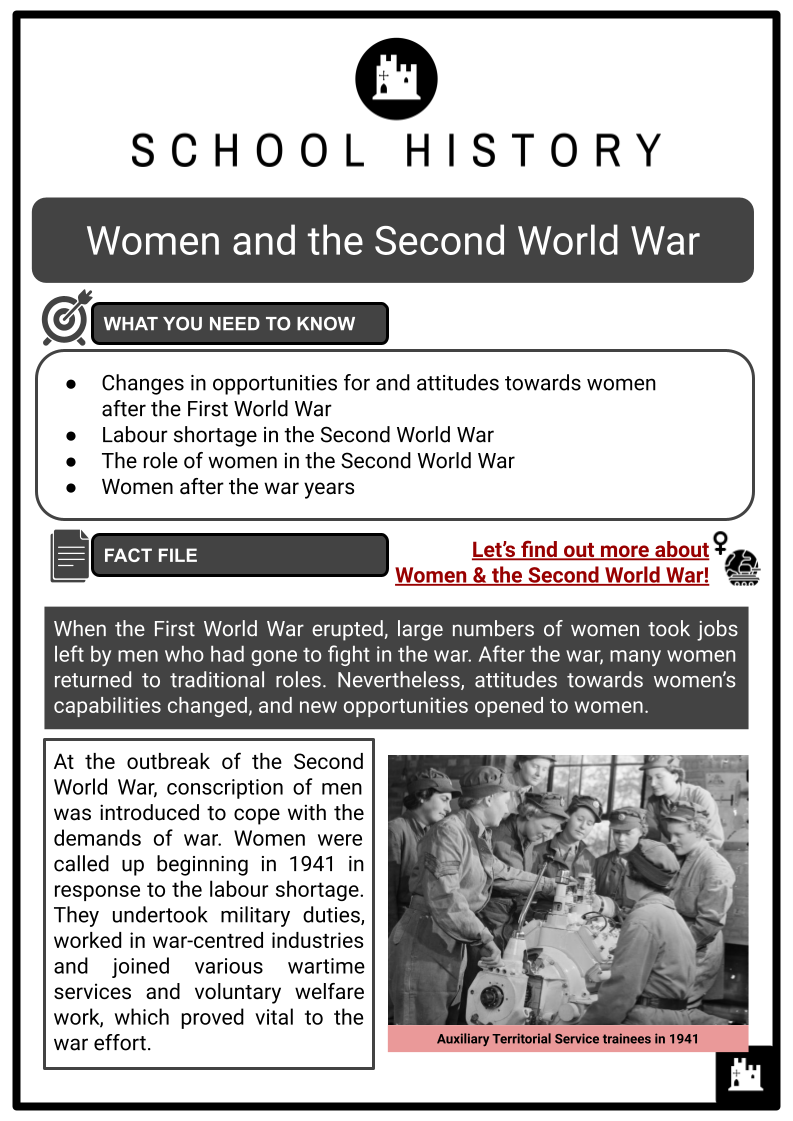
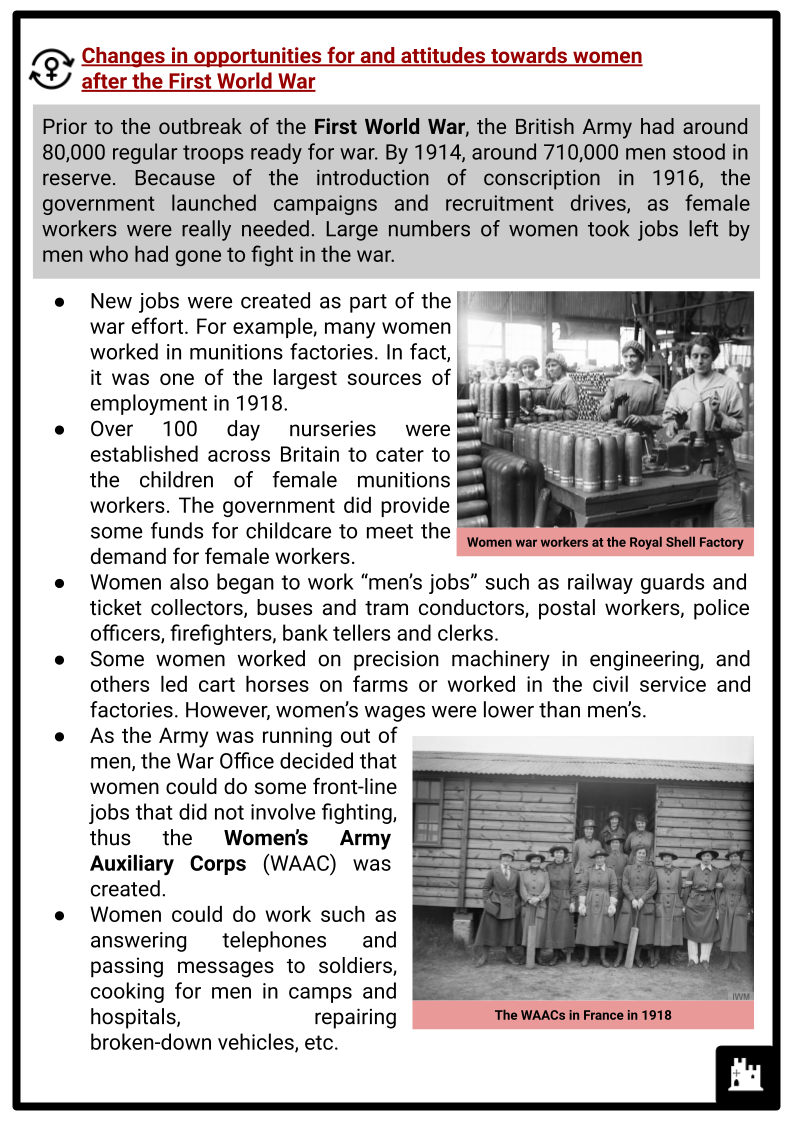
Student Activities
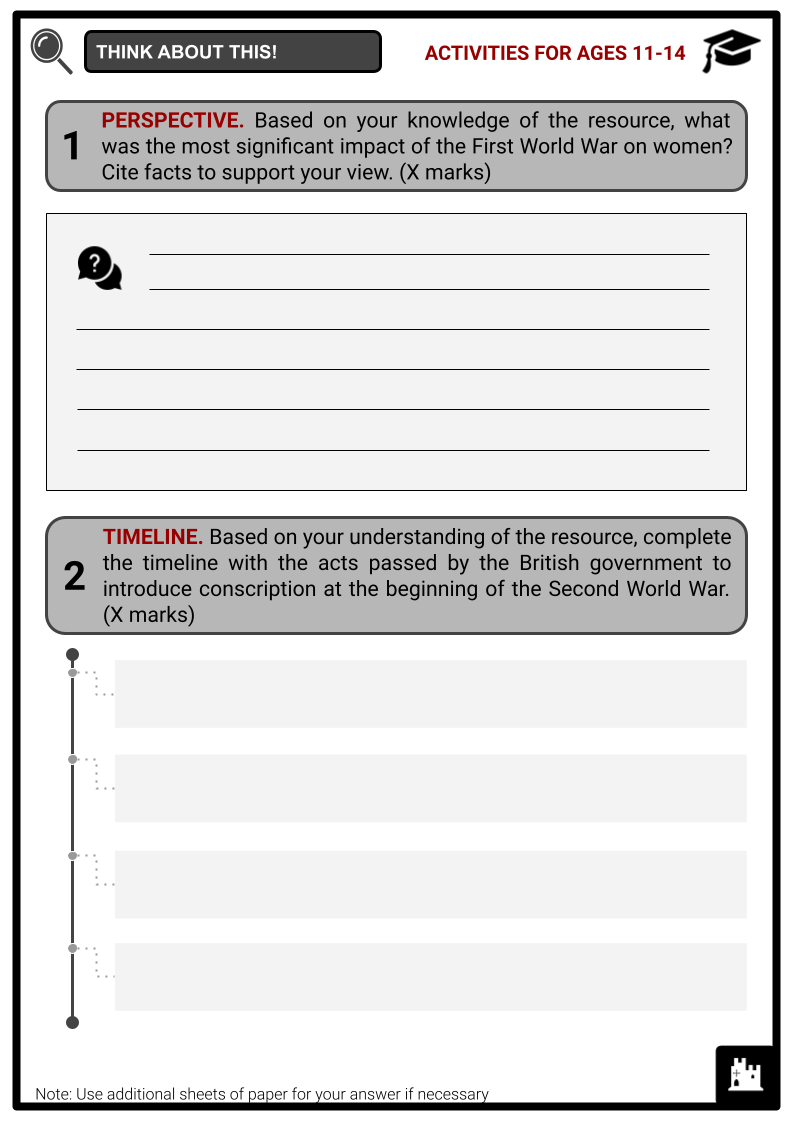
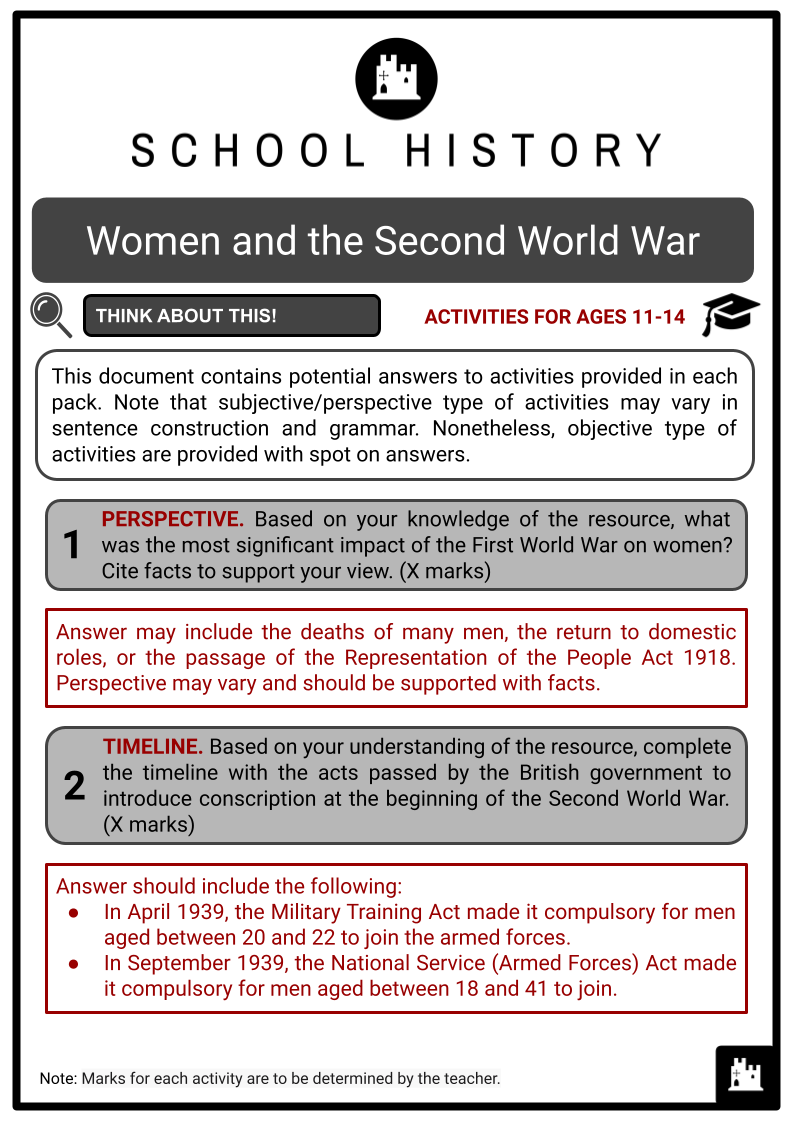
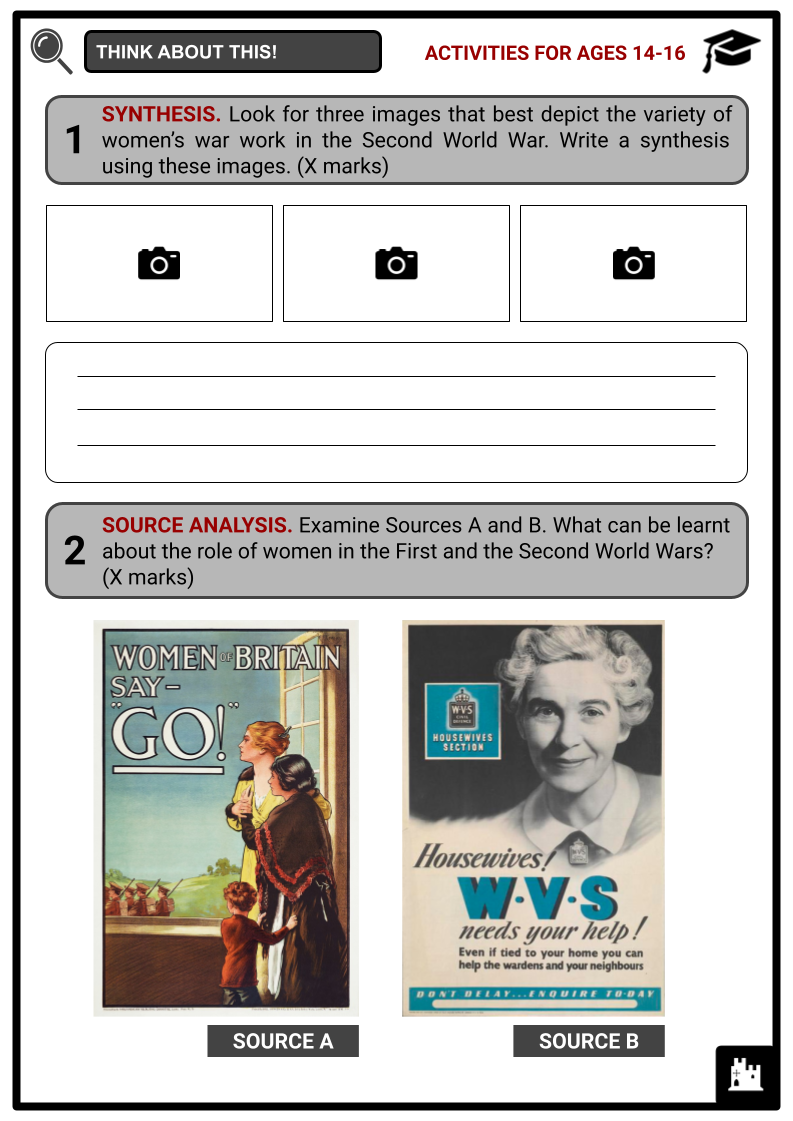
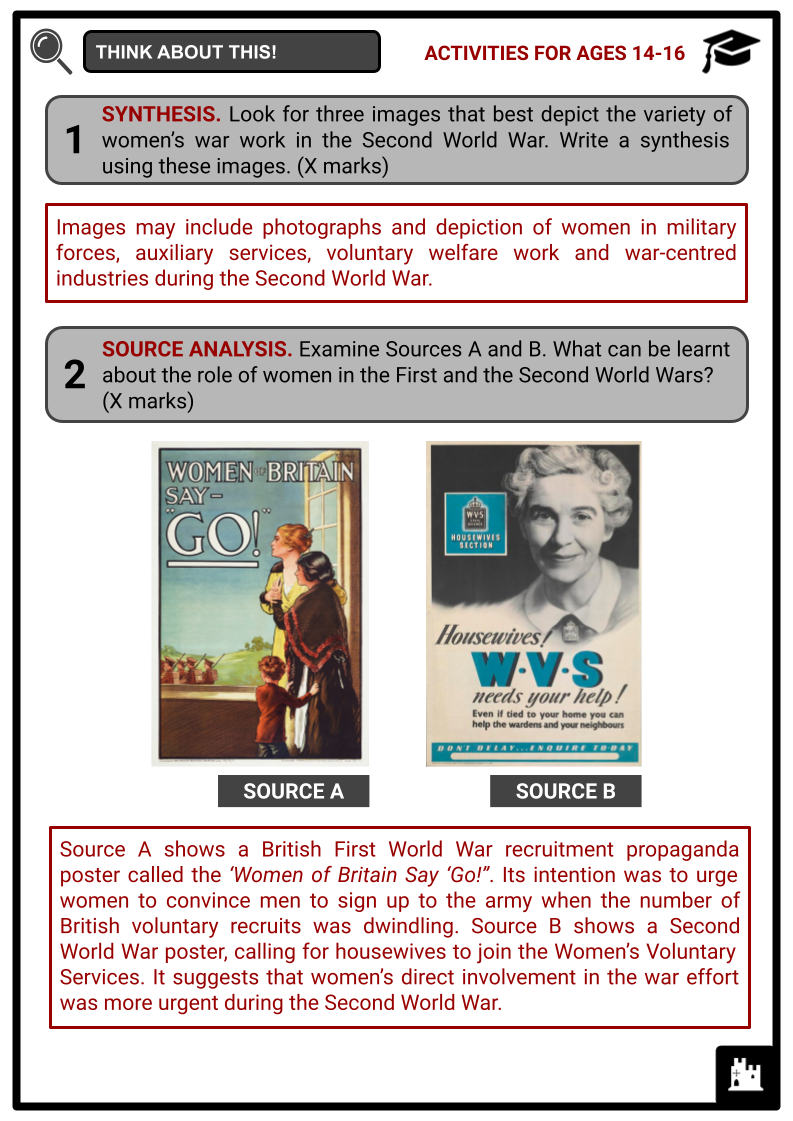
Summary
- Changes in opportunities for and attitudes towards women after the First World War
- Labour shortage in the Second World War
- The role of women in the Second World War
- Women after the war years
Key Facts And Information
Let’s find out more about Women & the Second World War!
When the First World War erupted, large numbers of women took jobs left by men who had gone to fight in the war. After the war, many women returned to traditional roles. Nevertheless, attitudes towards women’s capabilities changed, and new opportunities opened to women. At the outbreak of the Second World War, conscription of men was introduced to cope with the demands of war. Women were called up beginning in 1941 in response to the labour shortage. They undertook military duties, worked in war-centred industries and joined various wartime services and voluntary welfare work, which proved vital to the war effort.
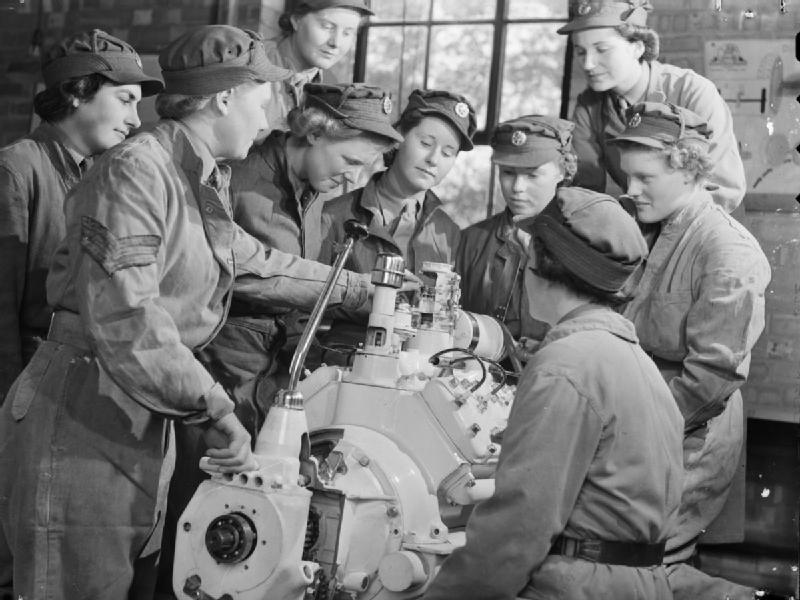
Changes in opportunities for and attitudes towards women after the First World War
- Prior to the outbreak of the First World War, the British Army had around 80,000 regular troops ready for war. By 1914, around 710,000 men stood in reserve. Because of the introduction of conscription in 1916, the government launched campaigns and recruitment drives, as female workers were really needed. Large numbers of women took jobs left by men who had gone to fight in the war.
- New jobs were created as part of the war effort. For example, many women worked in munitions factories. In fact, it was one of the largest sources of employment in 1918.
- Over 100 day nurseries were established across Britain to cater to the children of female munitions workers. The government did provide some funds for childcare to meet the demand for female workers.
- Women also began to work “men’s jobs” such as railway guards and ticket collectors, buses and tram conductors, postal workers, police officers, firefighters, bank tellers and clerks.
- Some women worked on precision machinery in engineering, and others led cart horses on farms or worked in the civil service and factories. However, women’s wages were lower than men’s.
- As the Army was running out of men, the War Office decided that women could do some front-line jobs that did not involve fighting, thus the Women’s Army Auxiliary Corps (WAAC) was created.
- Women could do work such as answering telephones and passing messages to soldiers, cooking for men in camps and hospitals, repairing broken-down vehicles, etc.
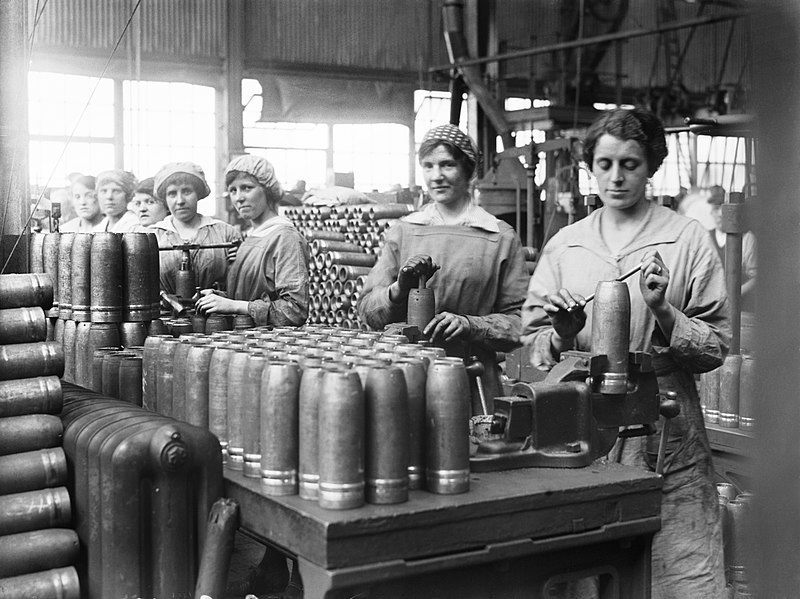
- To accommodate women in industry, employers had to alter the conditions of factories or workshops to the extent of making it possible for them to work side by side with men.
- This had been considered one of the obstacles in the way of the employment of women, but because of the shortage of workforce, this had been overcome.
- Between 1915 and 1918, at least one million women were added to the British workforce to ease the acute labour shortage.
- After the war, many women returned to traditional roles. Nevertheless, attitudes towards women’s capabilities had changed.
How else were women impacted by the First World War?
- Women’s lives had been dramatically reshaped by loss. Many women lost their husbands, fiancé or romantic partners to the war. This often meant that they lost the main breadwinner of the family. War widows were granted the first state-funded, non-contributory pension.
- The deaths of many men resulted in the ‘surplus’ of almost two million women in England and Wales after the war. This caused a change in society.
- During the war, concern over the proximity of women to enlisted men grew. Since Venereal Disease was a huge issue to the army at the time, Regulation 40D as an amendment to the Defence of the Realm Act was introduced. This decreed that women could be arrested on suspicion of transmitting VD to a member of His Majesty’s armed forces.
- Most suffrage organisations supported the women’s movements’ commitment to the war effort once the war broke out. The Women’s Social and Political Union (WSPU) geared its resources to mobilising women for the munitions industry and circulating patriotic propaganda.
- The significant contribution of women to the war effort was at least partially recognised in the Representation of the People Act 1918. Women over 30 with property were granted the right to vote in a general election. For men, all property qualifications were removed.
Labour shortage in the Second World War
- When the Second World War erupted in 1939, Britain was only in the early stages of rearmament. The government had made plans, recognising the dangers that Britain might face, including developing a programme to build new warships, informing the public about rationing, 'blackouts’ and gas masks, formation of a Ministry of Supply to ensure overseas supplies, and meeting with trade unions to ensure they agreed on wartime working regulations and wages. Furthermore, Britain made preparations for the people to get ready for war and turned to new technology to prepare for the German bombing.
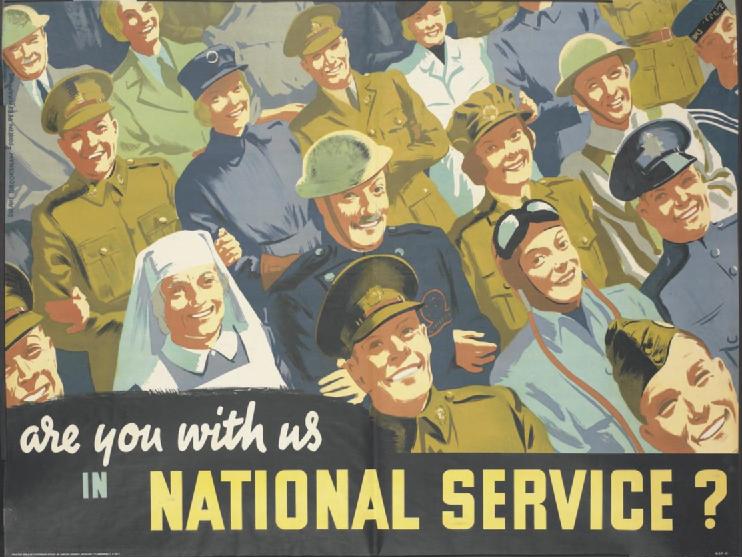
- When the war broke out, the armed forces were considerably small, hence the introduction of conscription aimed to cope with the demands of war.
- In April 1939, the Military Training Act made it compulsory for men aged between 20 and 22 to join the armed forces.
- In September 1939, the National Service (Armed Forces) Act made it compulsory for men aged between 18 and 41 to join.
- By the end of 1939, more than 1.5 million men had been conscripted to join the armed forces.
- The conscription of many young men into active service created a labour shortage.
- This became a crucial issue because the war effort required people not just to fight, but to also do critical jobs like work in munitions factories, drive trains and operate anti-aircraft guns.
- On 18 December 1941, Parliament passed the National Service Act, which called up men under 50, as well as unmarried women and childless widows aged between 20 and 30.
- The act was later extended to married women, although pregnant women and mothers with young children were exempt from this work. Meanwhile, men now needed to do some form of National Service up to the age of 60, which included military service for those under 51. Of the 2,800,000 new war workers, 79 percent were women.
The role of women in the Second World War
- Women’s contribution to the war effort proved vital during the First World War. The main reason for the conscription of women during the Second World War was to fill the demand for war work, in roles such as mechanics, engineers, munitions workers, air raid wardens, and bus and fire engine drivers.
What were the contributions of women?
- Women undertook military duties and could join one of the following: the Auxiliary Territorial Service (ATS), the Women’s Auxiliary Air Force (WAAF) or the Women’s Royal Naval Service (WRNS).
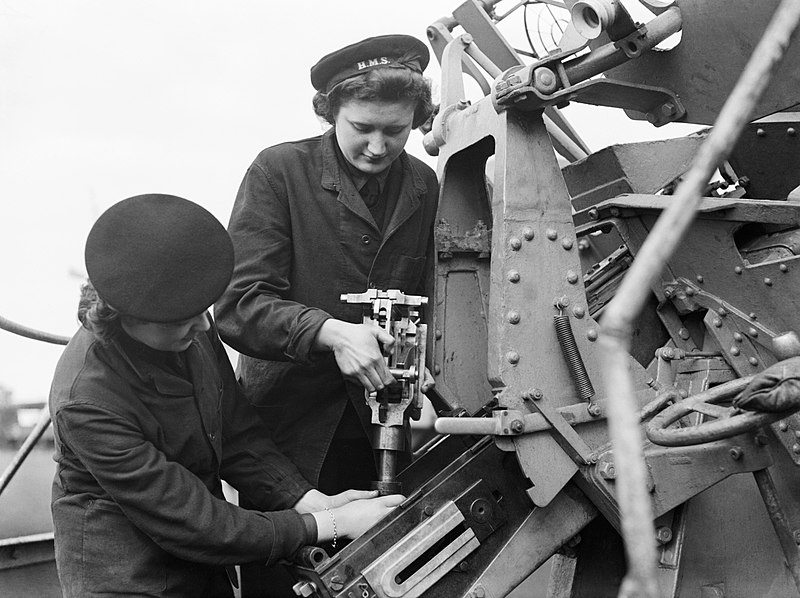
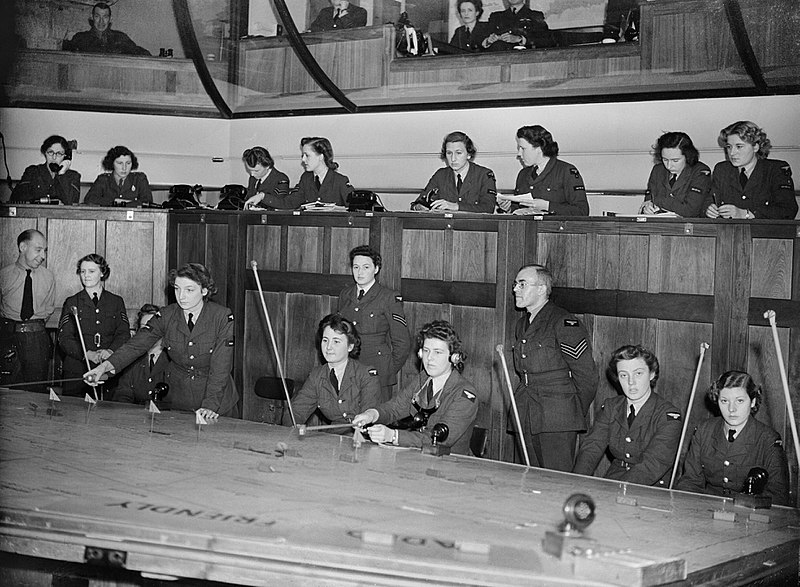
-
- Founded in 1938, the ATS originally included jobs such as clerks, orderlies, cooks, store women or drivers. It then expanded to include over a hundred different roles, which helped free up more men for front-line service. The ATS was the largest of the women’s services, with over 250,000 women serving in the Second World War.
- Formed in 1939, the WAAF sought to release RAF personnel for front-line duties. Its members grew to 182,000 by 1943. It had a variety of roles which consisted of compiling weather reports, maintaining aircraft, serving on airfields and assisting in intelligence.
- The WRNS was reorganised in 1939 and aimed to free up men for service at sea. Around 74,000 women joined this service and took over jobs on the shore, which initially included clerical and domestic duties. They played a vital role in the planning and organisation of naval operations. They were later asked to take on coding and cypher work from 1941, serving at Bletchley Park and its outstations.
Women were employed in war-centred industries.
-
- Women worked in factories to produce essential war material, such as aircraft, vehicles and munitions. The proportion of women working in these fields rose from 17.8 percent in 1939 to 38.2 percent in 1938.
- Whilst women who worked in factories were often well-paid, they were still given considerably lower wages than men. They fought for equal pay by agitating on a local level, often without the support of their unions. They were able to achieve this in a few industries during the war years.
- Their work also involved long hours, which proved difficult as they also needed to attend to domestic chores and caregiving. Consequently, many women were unable to hold their jobs.
- To assist female workers with childcare, thousands of state-funded nurseries opened across the country during the Second World War.
Women also joined other wartime services and voluntary welfare work.
-
- Women could join the Auxiliary Fire Service, which was tasked to supplement existing local fire services. They were mainly given administrative roles.
- In the Home Guard Auxiliaries, women assisted in secretarial work, telephone duties, and cooking.
- The Women’s Land Army was given the task of increasing food production. Women worked in all weathers and conditions and could be assigned to work anywhere in the country.
- The Women’s Voluntary Service was formed and had one million members by 1943. Their tasks involved knitting balaclavas and socks for servicemen, providing refreshments for those who sheltered in the Underground, and helping people who had lost their homes in the German bombings.
- Women also performed nursing roles at hospitals, including military ones
- The government encouraged the participation of women in the war effort and in a series of propaganda campaigns; the key message was, ‘There’s Not Much Women Can’t Do’. During the Second World War, there were over 640,000 women in the armed forces and over 6 million in civilian war work.
Women after the war years
- Women’s contributions during the Second World War were vital. Women proved their capability to undertake the jobs previously thought to be unfit for them. When the conflict ended, women were demobilised from the “men’s jobs” in order to make way for the returning servicemen. As the post-war reconstruction initiatives required an expanded labour force, the government started campaigns in the late 1940s to urge women to enter or stay in the labour market.
- Married women were demobilised sooner at the end of the war, so they could prepare their home for their returning spouses.
- Women turned to civilian jobs after the war. In fact, numerous job opportunities which were categorised as ‘women’s work’ became available in the succeeding years.
- Jobs remained strictly segregated by gender, and women were still paid lower wages than men. Hence, the campaign for equal pay continued.
- In 1948, the Army and Air Force (Women’s Service) Act was passed, creating the opportunity for a permanent peacetime role for women in the armed services.
- The involvement of women in the war effort gave way to the reorganisation of the Women’s Royal Air Force as a permanent force in 1949. About 80% of jobs became accessible to women. However, women were still restricted from engaging in combat duty.
- Meanwhile, the Women’s Voluntary Services, which was later renamed to Royal Voluntary Service, persists as a standing reserve force today.
- In 1997, the idea for a national monument to memorialise women’s contributions during the Second World War was initially proposed. In 2005, the Monument to the Women of World War II situated on Whitehall in London next to the Cenotaph at the end of Downing Street was unveiled by Queen Elizabeth II. This was in commemoration of the millions of women who contributed to the war effort by undertaking a multitude of crucial jobs.
Image Sources
- https://upload.wikimedia.org/wikipedia/commons/7/7e/At_An_ATS_Motor_Transport_Company_Training_Centre%2C_Camberley%2C_Surrey%2C_1941_D5719.jpg
- https://upload.wikimedia.org/wikipedia/commons/thumb/3/3b/Women_at_work_during_the_First_World_War_Q27873.jpg/800px-Women_at_work_during_the_First_World_War_Q27873.jpg?20171010003322
- https://upload.wikimedia.org/wikipedia/commons/3/3b/Are_You_with_Us_in_National_Service%3F_Art.IWMPST13964.jpg
- https://en.wikipedia.org/wiki/File:WAAF_plotters_at_work_in_the_Operations_Room_at_No._11_Group_HQ_at_Uxbridge_in_Middlesex,_1942._CH7698.jpg
- https://en.wikipedia.org/wiki/File:The_Women%27s_Royal_Naval_Service_during_the_Second_World_War_A15161.j
Frequently Asked Questions
- What roles did women play in World War II?
Women played various roles during World War II, including serving in the military, working in factories and farms, volunteering for civil defence and support organisations, and serving as nurses and medical personnel.
- Did women serve in combat during World War II?
While women in some countries served in auxiliary military roles, such as nursing and administrative positions, few were directly involved in combat. However, in the Soviet Union, women served in combat roles, particularly as snipers, pilots, and partisans.
- How did World War II change women's roles in society?
World War II led to pivotal changes in women's roles, as they took on traditionally held jobs by men serving in the military. This shift challenged traditional gender norms and paved the way for greater gender equality in the workforce after the war.
